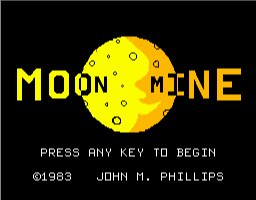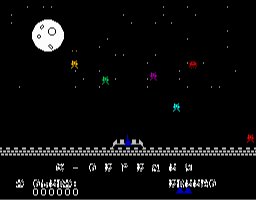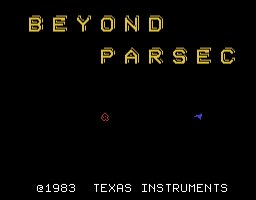This page is a tribute to the software written by John Phillips. Of his involvment with the 99/4A, John writes:
I started working for TI in their "IS&S" division in Dallas in 1982 after graduating from Illinois State in 1982. I owned a TI-99/4 that I bought from JC Penney in 1981 and learned to program it in Basic and Extended Basic. During my on-campus interviews with TI at Illinois State, I mentioned that I really wanted to work in the Home Computer Division, but TI felt my strengths were best served elsewhere. They offered me a position in Dallas working for their "IS&S" division.
While working in Dallas, TI announced an employee submissions program that would allow employees of TI to submit software for the Home Computer. Previously, TI employees were exempt from submisstions. There were two types: Class A and Class B. Class B was a one-time payment on $250 with no royalties. Class A was a 4-year royalty payment based on sales. I sent some Extended Basic games that I had written in college to Lubbock. They were accepted as class B and I received $250 apiece for 4 submissions. I called out to Lubbock and spoke with a man named Howard Hastings, who was the Development Manager for internal TI 99/4A software. I told him about my recent submissions and mentioned that I really wanted to work in Lubbock as a games programmer, but had been assigned to Dallas instead.
Howard must have pulled some strings and called me later to invite me to Lubbock to interview with the games development team. I was so young and na�ve that I responded, "Sure! How far of a drive is it?" Howard chuckled and said that they'd be more than happy to fly me. He arranged a transfer from Dallas in November of 1982 (something that is generally not allowed until a TI employee had completed one year of service). I moved to Lubbock in November of 1982 and was there until June of 1994.
Currently:
I am currently the CIO of USF Processors, an industry-leading reverse logistics firm in North Dallas. I live in Plano, TX with my wife, Kay and my three boys Jordan (12), Will (7) and Christian (2). You can visit my personal web site at http://members2.easyspace.com/phillipsj . Feel free to drop me a line.
John can be contacted at jphillips@USFProcessors.com
Moonmine | |||||||||
| Moonmine was assigned to me upon my arrival in Lubbock. I worked for a Supervisor, Bob Hendren, who had done a rough design and storyboard. I already knew how to program in assembly language, but did not know the proprietary language named "GPL" (Graphics Programming Language) that TI used in their GROM chips. I learned that from Jim Dramis (Car Wars, Munchman, Parsec). I worked on Moonmine for several months.
Bob Hendren and I had a falling out towards the end of the project. He wanted the same girl who did the Parsec speech (her name was Aubry) to do the Moonmine speech. I wanted someone else to do it. We ended up getting Aubry to record part of the speech and another TI Lubbock employee to record the voice of the Zygonaut. Bob and my relationship was never the same after that. |

| ||||||||
Hopper | |||||||||
| While I was working on Moonmine, my wife was working in the documentation group for TI (she wrote part of the Moonmine manual). There she met a man by the name of Mike Archuleta, who was a Supervisor in the QA group. We all went to a party together and she introduced me to Mike. Mike was brilliant and really wanted to do some programming. He came up with the idea of doing a game together, since he needed the technical guidance.
We went out to an arcade and found a coin operated game called, "Pengo." It had a penguin who pushed big ice blocks around the screen. We liked the concept and decided to use it. Instead of a penguin, we chose a Kangaroo. Instead of ice blocks, we chose crates. We did a storyboard on the game and divided up the programming. We also chose the TI Mini Memory cartridge as our intended platform, since there were no quality games that would fit in the 3.5K of RAM it contained. We coded for weeks and spent several late, late nights cutting code and optimizing code to get it to fit into the Mini Memory. Eventually, we did. I remember calling my parents at 4:00am because I was so excited that we had finished it. We submitted to TI and they accepted it as a Class A submission. They liked the game so much, though, that they asked us to add more to it because they wanted to produce a standalone cartridge of the game. So, we added title screens, two players, more levels, a surprise level, etc. Hopper was produced and released just before TI announced they were killing the computer and both Mike and I received royalty payments for about a year and a half. |

|
||||||||
D-Station I and II | |||||||||
| I started developing a friendship with Charlie La Fara, who was the president of the IUG. I developed some Extended Basic games for his IUG. He created a contest for the best software submission and, over a weekend, I converted an Extended Basic game I had developed in college to Assembly language. He flew me to Oklahoma City and I showed him the game. It won his contest easily and he said, "let's make a buck on this." He wanted to produce his own cartridge, so I had to get permission from TI to release the code. I renamed the game "Bomb the Aeroflot," which was a political hotspot over the Russian shooting of a passenger plane and submitted the game to TI. They rejected the submission due to its political nature and I submitted it to Charlie as D-Station. A few months later, I enhanced the game and created D-Station II. |  | ||||||||
Beyond Parsec (Beyond Space) | |||||||||
| With Parsec's popularity, I felt a 2-player version would be a sure hit. I created a storyboard concept and began coding the software as a submission to TI. The concept was two ships in a moveable asteroid field. The asteroids would move if they were fired upon, so they could be used as both an offensive and defensive weapon. I used the sound effects created for Parsec and submitted it to TI. They loved it and accepted it as a Class A submisstion. But TI announced they were killing the home computer. They released the software back to me with the condition that I did not use the Parsec name. So, I renamed the game "Beyond Space." | 
| ||||||||
Star Trap | |||||||||
| While at TI, I started developing a game at home based on the Star Wars coin operated arcade game. I created a title screen and complete game, but did not finish it before TI bailed out of the home computer market. I renamed the game "Star Trap" and sent the game to Triton, who was then licensed to produce and distribute TI software and hardware. The development coordinator at Triton was a man by the name of Bruce Jaffe. Together, Bruce and I would create a partnership and I would go on to create and sell other innovative software titles including:
Star Gazer I, II and III 4A Flyer Strike Three! The Great Word Race Face Chase Munchman II | |||||||||
 Download the Strike Three manual - 365KB (You need to download the free PaperPort Viewer software to view this file) Download the Strike Three manual - 365KB (You need to download the free PaperPort Viewer software to view this file) | |||||||||
| |||||||||
Word Radar | |||||||||
| After Moonmine, TI asked me to work on a conversion of a software product by DLM (Developmental Learning Materials) in Allen, Texas. DLM had a successful set of educational software products for the Apple computer and entered into an agreement with TI to convert their titles to the TI-99/4A. One of the titles, "Word Radar" was assigned to me. I did the conversion in 2 weeks and sent it to DLM for QA and final approval. The president of DLM, Andy Bingham, remembered how quickly I had done his conversion. When TI bailed out of the home computer, Andy Bingham called me at home in Lubbock and offered me a job working for DLM, who did none of their own software (it was all 3rd party authoring). I took that job and continued to produce educational software for Apple, IBM, Atari, Commodore and TI for two years before leaving DLM to work for Frito-Lay. | 
|
||||||||
Screen shots are still needed for the following games: D-Station I (corrupt), Star Trap, and Word Radar. If you have one to contribute, please contact Rich at webmaster@99er.net.